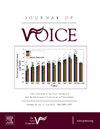评估老年喉科人群中喉老患病率及相关危险因素
IF 2.4
4区 医学
Q1 AUDIOLOGY & SPEECH-LANGUAGE PATHOLOGY
引用次数: 0
摘要
目的:本研究的主要目的是评估在三级护理喉科就诊的老年患者中,喉老症的患病率及其相关特征。本研究的次要目的是比较喉部肌电图(LEMG)结果、共存的VF条件、病史、手术史、药物使用和其他参数在有和没有喉部老年性喉炎患者之间。方法选择60岁及以上行频闪视频喉镜检查的成人嗓音患者。根据三位盲法作者(GA、KL和HP)的频闪视频喉镜(SVL)分级检查结果的大多数(≥2/3)一致性,将患者分配到两组中的一组,以发现与喉老(声带萎缩[VFA]、声带弯曲[VFB]、声带突突出[VPP]和声门前功能不全[GI])相符的结果。患者人口统计资料、病史、手术史、药物使用、实验室结果和SVL视频被汇编。采用SPSS 28.0.0.0 (IBM, Armonk, NY)进行统计学分析。所有检验均采用双侧检验,p值小于0.05认为具有统计学意义。结果共纳入164例患者,其中女性84例,男性80例,平均年龄68.397±4.947岁。在研究人群中,喉老患病率为52.4% (n = 86)。喉老组患者的平均年龄明显高于非喉老组。此外,在喉老组中,男性明显多于女性。喉老组也有较高比例的ACE抑制剂(ACEi)的使用。此外,实验室结果显示,在喉老组中,促甲状腺激素(TSH)水平升高的患者比例明显更高。相反,非喉老组的患者使用左甲状腺素的比例明显更高。在SVL上,非喉老队列患者发现良性声带病变和声带轻瘫的比例明显更高。然而,LEMG测试显示,两组之间的肌肉恢复没有统计学上的显著差异。研究发现,与患有喉部老年性疾病的女性相比,男性患VFB和VPP的比例明显更高。结论本回顾性研究调查了喉科医生治疗的患者中喉老的患病率及相关危险因素。即使同时存在VF,也可观察到与喉部早老性相符的征象。年龄较大、TSH升高、ACEi的使用和男性与SVL上的喉老症状相关。在那些被诊断为喉部老年性喉炎的患者中,男性的VFB和VPP比例高于女性。我们鼓励更多关于喉老的教育和进一步的研究,以提高其诊断标准的标准化,以及它与其他VF疾病的关系,以改善老化声音的管理。本文章由计算机程序翻译,如有差异,请以英文原文为准。
Assessing the Prevalence and Associated Risk Factors for Presbylarynx in the Elderly Laryngology Population
Objective
The primary objective of this study was to assess the prevalence of presbylarynx and its associated features in an elderly population representative of patients seen in a tertiary care laryngology practice. The secondary objective of this study was to compare laryngeal electromyography (LEMG) findings, coexisting VF conditions, medical history, surgical history, medication use, and other parameters between patients with and without presbylarynx.
Methods
Adult voice patients aged 60 years and older who underwent strobovideolaryngoscopy were included in the study. Patients were assigned to one of two groups based on the majority (≥2/3) agreement of three blinded authors’ (GA, KL, and HP) graded examinations of strobovideolaryngoscopy (SVL) videos for findings consistent with presbylarynx (atrophic vocal folds [VFA], vocal fold bowing [VFB], vocal process prominence [VPP] and anterior glottic insufficiency [GI]). Patient demographics, medical history, surgical history, medication use, laboratory results, and SVL videos were compiled. Statistical analysis was performed using SPSS 28.0.0.0 (IBM, Armonk, NY). All tests were performed two-tailed, and a P-value of less than 0.05 was considered statistically significant.
Results
One hundred sixty-four patients (84 female/80 male, mean age of 68.397 ± 4.947 years) were included in this study. The prevalence of presbylarynx was 52.4% (n = 86) in the study population. The mean age of patients in the presbylarynx group was significantly higher than the nonpresbylarynx group. Additionally, there were significantly more males than females in the presbylarynx group. The presbylarynx group also was found to have a higher proportion of ACE inhibitor (ACEi) use. Further, laboratory results revealed a significantly higher proportion of patients with elevated thyroid stimulating hormone (TSH) levels in the presbylarynx group. Conversely, patients in the nonpresbylarynx group were found to have a significantly higher rate of levothyroxine use. On SVL, patients in the nonpresbylarynx cohort were found to have a significantly higher proportion of benign vocal fold lesions and vocal fold paresis. However, LEMG testing revealed no statistically significant differences in muscle recruitment between groups. Men with presbylarynx were found to have a significantly higher proportion of VFB and VPP compared to women with presbylarynx.
Conclusion
This retrospective study investigated the prevalence and risk factors associated with presbylarynx in patients representative of those treated by laryngologists. Signs consistent with presbylarynx are observable even in the presence of coexisting VF conditions. Older age, elevated TSH, the use of ACEi, and male gender was associated with signs of presbylarynx on SVL. Of those diagnosed with presbylarynx, males were identified as having higher proportions of VFB and VPP compared to females. More education regarding presbylarynx and further studies to improve standardization of the criteria for its diagnosis, as well as its relationship with other VF conditions, are encouraged to improve management of the aging voice.
求助全文
通过发布文献求助,成功后即可免费获取论文全文。
去求助
来源期刊

Journal of Voice
医学-耳鼻喉科学
CiteScore
4.00
自引率
13.60%
发文量
395
审稿时长
59 days
期刊介绍:
The Journal of Voice is widely regarded as the world''s premiere journal for voice medicine and research. This peer-reviewed publication is listed in Index Medicus and is indexed by the Institute for Scientific Information. The journal contains articles written by experts throughout the world on all topics in voice sciences, voice medicine and surgery, and speech-language pathologists'' management of voice-related problems. The journal includes clinical articles, clinical research, and laboratory research. Members of the Foundation receive the journal as a benefit of membership.
 求助内容:
求助内容: 应助结果提醒方式:
应助结果提醒方式:


